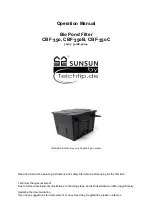
195
PO
SAVE THESE INSTRUCTIONS
(195PO) SAND FILTER PUMP ENGLISH 7.5” X 10.3” PANTONE 295U 06/29/2016
English
Page 22
COMMON POOL PROBLEMS
PROBLEM DESCRIPTION CAUSE SOLUTION
ALGAE
COLORED
WATER
FLOATING
MATTER IN
WATER
CHRONIC
LOW WATER
LEVEL
SEDIMENT
ON POOL
BOTTOM
SURFACE
DEBRIS
• Chlorine and pH levels
need adjustment.
• Copper, iron or maganese
in water being oxidized by
the added chlorine. This is
Common.
• "Hard water" caused by
a too high pH level.
• Chlorine content is low.
• Foreign matter in water.
• Rip or hole in pool liner or
hoses.
• The drain valves are loose.
• Heavy use, getting in and
out of pool.
• Pool too close to trees.
• Super chlorinate with shock
treatment. Correct pH to your
pool store's recommended
level.
• Vacuum pool bottom.
• Maintain proper chlorine
level.
• Adjust pH level to the
recommended
level.
• Run filter until water is clear.
• Correct the pH level. Check
with your pool dealer for
advice.
• Adjust the chlorine level.
• Repair with a patch kit.
• Finger tighten all caps.
• Use Intex pool vacuum to
clean bottom of pool.
• Use Intex pool skimmer.
• Greenish water.
• Green or black spots
on pool liner.
• Pool liner is slippery
and/or has a bad odor.
• Water turns blue, brown,
or black when first
treated with chlorine.
• Water is cloudy or
milky.
• Level is lower than
on previous day.
• Dirt or sand on pool floor.
• Leaves, insects etc.
Operation is subject to the following two conditions: (1) this device may not cause interference,
and (2) this device must accept any interference, including interference that may cause undesired
operation of the device.
Changes or modifications not expressly approved by the party responsible for compliance could
void the user’s authority to operate the equipment.
This equipment has been tested and found to comply with the limits for Class B digital device,
pursuant to part 15 of the FCC Rules. These limits are designed to provide reasonable protection
against harmful interference in a residential installation. This equipment generates, uses and can
radiate radio frequency energy and, if not installed and used in accordance with the instructions,
may cause harmful interference to radio communications. However, there is no guarantee that
interference will not occur in a particular installation. If this equipment does cause harmful
interference to radio or television reception, which can be determined by turning the equipment off
and on, the user is encouraged to try to correct the interference by one or more of the following
measures:
•
Reorient or relocate the receiving antenna.
•
Increase the separation between the equipment and the receiver.
•
Connect the equipment into an outlet on a circuit different from that to which the receiver is
connected.
•
Consult the dealer or an experienced radio/TV technician for help.



































